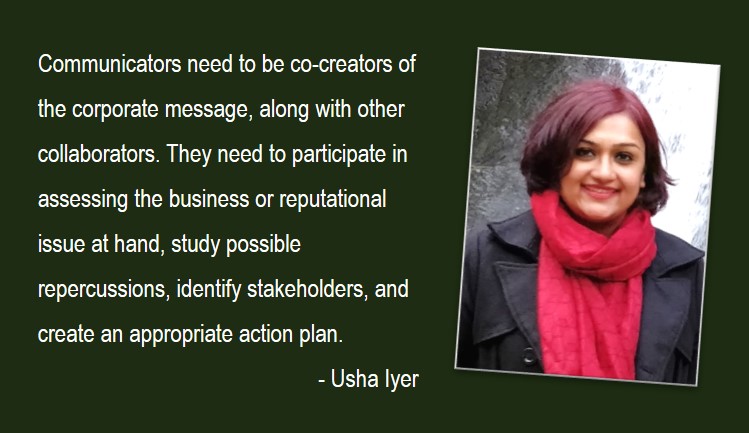As a first-time contributor to this magazine which I follow so eagerly, I feel compelled to highlight, right at the outset, that several disclaimers apply here – views are my own, views are from the perspective of relatively early-stage observations of the corporate communication profession, and that the below piece has benefited from and is an attempt to build on previously expressed views of communicators. As someone attempting to find her niche in the profession, I have had the opportunity to be privy to some extremely important—existential—conversations that corporate communication professionals appear to be asking themselves and each other, and this is my synthesis of them.
First, the mother issue. Where does the function stand in the corporate value chain? There cannot be too many dissenting voices from within the profession to the belief that the communications function has potential for a strategic role in any firm and cannot merely be a “support function”. At no point can we be content to act as a mailing list and simply disseminate a message delivered on a platter to us. We need a seat at the messaging table. We need to be co-creators of the message along with other collaborators. We need to participate in assessing the business or reputational issue at hand, study possible repercussions, identify stakeholders, and create an appropriate action plan.
The question to ask appears to be – Does communications automatically get a seat at this table? Or is communications, as a function, still trying to establish its credentials? Or is the function a person-centric one?
Effectiveness as a co-creator of messaging may very well be determined by how ‘business-aligned’ we are. Once again, there is no denying the importance of this characteristic. It must be assumed as accepted that the communications function does not exist in a vacuum, and that there cannot be a one-size-fits-all approach to communications strategy. It exists within the universe of its business sector. But how is the success of this characteristic measured? Is it about how deeply one understands the nuances of the business? Or about how one marries demands of business strategy with core functional competencies? Or to what extent one is an influencer among internal and external stakeholders, and how proactively one invests in managing longterm perceptions as opposed to reacting to developments or moments in the present? Is ‘business-aligned communication’ an elusive holy grail, or a spectrum? Perhaps there are case-studies from across sectors that can inform developing professionals.
Again, if we are to work towards collaborative creation of messaging, how much attention do we pay to investing in in-house synergy? In partnership with relevant internal teams? There will be knowing nods from many corporate professionals—and not just from within communications—when the topic of difficulties in cross-functional work is discussed. And yet, as Dilip Yadav brilliantly diagnosed in his recent article, The Matrix Reloaded – Navigating the CFO-Communicator dynamics it is an absolute must in order to be effective communicators. In a corporate set-up, partnership to co-create messaging goes beyond communications and finance, and such synergy will be a strength rather than a pain point or forced necessity for any firm. More importantly, this is where thought leadership of the function comes into play.
My intention here is not to present a simplistic picture of our entire body of work, or to paint with a broad brush. There is too much diversity in the communications work for it to be fully captured or defined by the above questions. We are, after all, in the profession of building brands, profiles and reputations – a ‘minefield’, if one were to try to describe it one word!
Rather, in my conversations, exchanges and discussions, I have sensed an underlying issue, and one which perhaps needs to be put to professionals across the value chain of a corporate. Are we a function that is still looking for further maturity (or, to be blunt, one that perhaps harbours an inferiority complex), or are we a confident function that is capable of being an equal strategic partner? If the former, then what makes us so and what can we do? If the latter, then are we looking at unconstrained professional mobility in the value chain?
The views expressed here are that of the author and do not necessarily reflect that of Reputation Today or of the organisation that the author belongs to.







Be the first to comment on "The communications function in the corporate value chain"